The Zane Grey Megapack Read online
COPYRIGHT INFO
The Zane Grey Megapack is copyright © 2013 by Wildside Press LLC.
* * * *
“The Horses of Bostil’s Ford” is taken from Munsey’s Magazine, June 1912.
“Fantoms of Peace,” is taken from Munsey’s Magazine, January 1913.
“The Wild-Horse Hunter” is taken from The Boy Scouts Book of Campfire Stories (1933).
A NOTE FROM THE PUBLISHER
The various Western volumes we’ve produced have ranked among the most popular entries in the Megapack series. (See The Western Megapack, The Second Western Megapack, The Max Brand Megapack, and The B.M. Bower Megapack.) Now we’re pleased to add The Zane Grey Megapack—a compilation of 42 novels and short stories, including many set in the Old West (and a nice selection of Grey’s baseball stories).
* * * *
Over the last year, our “Megapack” series of ebook anthologies has proved to be one of our most popular endeavors. (Maybe it helps that we sometimes offer them as premiums to our mailing list!) One question we keep getting asked is, “Who’s the editor?”
The Megapacks (except where specifically credited) are a group effort. Everyone at Wildside works on them. This includes John Betancourt, Carla Coupe, Steve Coupe, Bonner Menking, Colin Azariah-Kribbs, A.E. Warren, and many of Wildside’s authors…who often suggest stories to include (and not just their own!).
A NOTE FOR KINDLE READERS
The Kindle versions of our Megapacks employ active tables of contents for easy navigation…please look for one before writing reviews on Amazon that complain about the lack! (They are sometimes at the ends of ebooks, depending on your reader.)
RfECOMMEND A FAVORITE STORY?
Do you know a great classic science fiction story, or have a favorite author whom you believe is perfect for the Megapack series? We’d love your suggestions! You can post them on our message board at http://movies.ning.com/forum (there is an area for Wildside Press comments).
Note: we only consider stories that have already been professionally published. This is not a market for new works.
TYPOS
Unfortunately, as hard as we try, a few typos do slip through. We update our ebooks periodically, so make sure you have the current version (or download a fresh copy if it’s been sitting in your ebook reader for months.) It may have already been updated.
If you spot a new typo, please let us know. We’ll fix it for everyone. You can email the publisher at [email protected] or use the message boards above.
—John Betancourt
Publisher, Wildside Press LLC
www.wildsidepress.com
THE MEGAPACK SERIES
MYSTERY
The Achmed Abdullah Megapack
The Craig Kennedy Scientific Detective Megapack
The Detective Megapack
The Father Brown Megapack
The Jacques Futrelle Megapack
The Mystery Megapack
The Penny Parker Megapack
The Pulp Fiction Megapack
The Victorian Mystery Megapack
The Wilkie Collins Megapack
GENERAL INTEREST
The Adventure Megapack
The Baseball Megapack
The Christmas Megapack
The Second Christmas Megapack
The Classic Humor Megapack
The Military Megapack
FANTASY & HORROR
The Achmed Abdullah Megapack
The E.F. Benson Megapack
The Second E.F. Benson Megapack
The Cthulhu Mythos Megapack
The Ghost Story Megapack
The Second Ghost Story Megapack
The Third Ghost Story Megapack
The Horror Megapack
The M.R. James Megapack
The Macabre Megapack
The Second Macabre Megapack
The Mummy Megapack
The Pinocchio Megapack
The Pulp Fiction Megapack
The Vampire Megapack
The Werewolf Megapack
The Wizard of Oz Megapack
SCIENCE FICTION
The First Science Fiction Megapack
The Second Science Fiction Megapack
The Third Science Fiction Megapack
The Fourth Science Fiction Megapack
The Fifth Science Fiction Megapack
The Sixth Science Fiction Megapack
*
The Edward Bellamy Megapack
The First Reginald Bretnor Megapack
The Philip K. Dick Megapack
The Randall Garrett Megapack
The Second Randall Garrett Megapack
The Murray Leinster Megapack
The Second Murray Leinster Megapack
The Martian Megapack
The Andre Norton Megapack
The H. Beam Piper Megapack
The Pulp Fiction Megapack
The Steampunk Megapack
WESTERNS
The B.M. Bower Megapack
The Max Brand Megapack
The Buffalo Bill Megapack
The Cowboy Megapack
The Zane Grey Megapack
The Western Megapack
The Second Western Megapack
The Wizard of Oz Megapack
YOUNG ADULT
The Boys’ Adventure Megapack
The Dan Carter, Cub Scout Megapack
The G.A. Henty Megapack
The Rover Boys Megapack
The Tom Corbett, Space Cadet Megapack
The Tom Swift Megapack
AUTHOR MEGAPACKS
The Achmed Abdullah Megapack
The Edward Bellamy Megapack
The B.M. Bower Megapack
The E.F. Benson Megapack
The Second E.F. Benson Megapack
The Max Brand Megapack
The First Reginald Bretnor Megapack
The Wilkie Collins Megapack
The Philip K. Dick Megapack
The Jacques Futrelle Megapack
The Randall Garrett Megapack
The Second Randall Garrett Megapack
The M.R. James Megapack
The Murray Leinster Megapack
The Second Murray Leinster Megapack
The Andre Norton Megapack
The H. Beam Piper Megapack
The Rafael Sabatini Megapack
BETTY ZANE (1903) [Part 1]
TO THE BETTY ZANE CHAPTER OF THE DAUGHTERS OF THE REVOLUTION THIS BOOK IS RESPECTFULLY DEDICATED BY THE AUTHOR
NOTE
In a quiet corner of the stately little city of Wheeling, West Va., stands a monument on which is inscribed:
“By authority of the State of West Virginia to commemorate the siege of Fort Henry, Sept 11, 1782, the last battle of the American Revolution, this tablet is here placed.”
Had it not been for the heroism of a girl the foregoing inscription would never have been written, and the city of Wheeling would never have existed. From time to time I have read short stories and magazine articles which have been published about Elizabeth Zane and her famous exploit; but they are unreliable in some particulars, which is owing, no doubt, to the singularly meagre details available in histories of our western border.
For a hundred years the stories of Betty and Isaac Zane have been familiar, oft-repeated tales in my family—tales told with that pardonable ancestral pride which seems inherent in every one. My grandmother loved to cluster the children round her and tell them that when she was a little girl she had knelt at the feet of Betty Zane, and listened to the old lady as she told of her brother’s capture by the Indian Princess, of the burning of the Fort, and of her own race for life. I knew these stories by heart when a child.
Two years ago my mother came to
me with an old note book which had been discovered in some rubbish that had been placed in the yard to burn. The book had probably been hidden in an old picture frame for many years. It belonged to my great-grandfather, Col. Ebenezer Zane. From its faded and time-worn pages I have taken the main facts of my story. My regret is that a worthier pen than mine has not had this wealth of material.
In this busy progressive age there are no heroes of the kind so dear to all lovers of chivalry and romance. There are heroes, perhaps, but they are the patient sad-faced kind, of whom few take cognizance as they hurry onward. But cannot we all remember someone who suffered greatly, who accomplished great deeds, who died on the battlefield—someone around whose name lingers a halo of glory? Few of us are so unfortunate that we cannot look backward on kith or kin and thrill with love and reverence as we dream of an act of heroism or martyrdom which rings down the annals of time like the melody of the huntsman’s horn, as it peals out on a frosty October morn purer and sweeter with each succeeding note.
If to any of those who have such remembrances, as well as those who have not, my story gives an hour of pleasure I shall be rewarded.
PROLOGUE
On June 16, 1716, Alexander Spotswood, Governor of the Colony of Virginia, and a gallant soldier who had served under Marlborough in the English wars, rode, at the head of a dauntless band of cavaliers, down the quiet street of quaint old Williamsburg.
The adventurous spirits of this party of men urged them toward the land of the setting sun, that unknown west far beyond the blue crested mountains rising so grandly before them.
Months afterward they stood on the western range of the Great North mountains towering above the picturesque Shenandoah Valley, and from the summit of one of the loftiest peaks, where, until then, the foot of a white man had never trod, they viewed the vast expanse of plain and forest with glistening eyes. Returning to Williamsburg they told of the wonderful richness of the newly discovered country and thus opened the way for the venturesome pioneer who was destined to overcome all difficulties and make a home in the western world.
But fifty years and more passed before a white man penetrated far beyond the purple spires of those majestic mountains.
One bright morning in June, 1769, the figure of a stalwart, broad shouldered man could have been seen standing on the wild and rugged promontory which rears its rocky bluff high above the Ohio river, at a point near the mouth of Wheeling Creek. He was alone save for the companionship of a deerhound that crouched at his feet. As he leaned on a long rifle, contemplating the glorious scene that stretched before him, a smile flashed across his bronzed cheek, and his heart bounded as he forecast the future of that spot. In the river below him lay an island so round and green that it resembled a huge lily pad floating placidly on the water. The fresh green foliage of the trees sparkled with glittering dewdrops. Back of him rose the high ridges, and, in front, as far as eye could reach, extended an unbroken forest.
Beneath him to the left and across a deep ravine he saw a wide level clearing. The few scattered and blackened tree stumps showed the ravages made by a forest fire in the years gone by. The field was now overgrown with hazel and laurel bushes, and intermingling with them were the trailing arbutus, the honeysuckle, and the wild rose. A fragrant perfume was wafted upward to him. A rushing creek bordered one edge of the clearing. After a long quiet reach of water, which could be seen winding back in the hills, the stream tumbled madly over a rocky ledge, and white with foam, it hurried onward as if impatient of long restraint, and lost its individuality in the broad Ohio.
This solitary hunter was Colonel Ebenezer Zane. He was one of those daring men, who, as the tide of emigration started westward, had left his friends and family and had struck out alone into the wilderness. Departing from his home in Eastern Virginia he had plunged into the woods, and after many days of hunting and exploring, he reached the then far Western Ohio valley.
The scene so impressed Colonel Zane that he concluded to found a settlement there. Taking “tomahawk possession” of the locality (which consisted of blazing a few trees with his tomahawk), he built himself a rude shack and remained that summer on the Ohio.
In the autumn he set out for Berkeley County, Virginia, to tell his people of the magnificent country he had discovered. The following spring he persuaded a number of settlers, of a like spirit with himself, to accompany him to the wilderness. Believing it unsafe to take their families with them at once, they left them at Red Stone on the Monongahela river, while the men, including Colonel Zane, his brothers Silas, Andrew, Jonathan and Isaac, the Wetzels, McCollochs, Bennets, Metzars and others, pushed on ahead.
The country through which they passed was one tangled, most impenetrable forest; the axe of the pioneer had never sounded in this region, where every rod of the way might harbor some unknown danger.
These reckless bordermen knew not the meaning of fear; to all, daring adventure was welcome, and the screech of a redskin and the ping of a bullet were familiar sounds; to the Wetzels, McCollochs and Jonathan Zane the hunting of Indians was the most thrilling passion of their lives; indeed, the Wetzels, particularly, knew no other occupation. They had attained a wonderful skill with the rifle; long practice had rendered their senses as acute as those of the fox. Skilled in every variety of woodcraft, with lynx eyes ever on the alert for detecting a trail, or the curling smoke of some camp fire, or the minutest sign of an enemy, these men stole onward through the forest with the cautious but dogged and persistent determination that was characteristic of the settler.
They at length climbed the commanding bluff overlooking the majestic river, and as they gazed out on the undulating and uninterrupted area of green, their hearts beat high with hope.
The keen axe, wielded by strong arms, soon opened the clearing and reared stout log cabins on the river bluff. Then Ebenezer Zane and his followers moved their families and soon the settlement began to grow and flourish. As the little village commenced to prosper the redmen became troublesome. Settlers were shot while plowing the fields or gathering the harvests. Bands of hostile Indians prowled around and made it dangerous for anyone to leave the clearing. Frequently the first person to appear in the early morning would be shot at by an Indian concealed in the woods.
General George Rodgers Clark, commandant of the Western Military Department, arrived at the village in 1774. As an attack from the savages was apprehended during the year the settlers determined to erect a fort as a defense for the infant settlement. It was planned by General Clark and built by the people themselves. At first they called it Fort Fincastle, in honor of Lord Dunmore, who, at the time of its erection, was Governor of the Colony of Virginia. In 1776 its name was changed to Fort Henry, in honor of Patrick Henry.
For many years it remained the most famous fort on the frontier, having withstood numberless Indian attacks and two memorable sieges, one in 1777, which year is called the year of the “Bloody Sevens,” and again in 1782. In this last siege the British Rangers under Hamilton took part with the Indians, making the attack practically the last battle of the Revolution.
CHAPTER I.
The Zane family was a remarkable one in early days, and most of its members are historical characters.
The first Zane of whom any trace can be found was a Dane of aristocratic lineage, who was exiled from his country and came to America with William Penn. He was prominent for several years in the new settlement founded by Penn, and Zane street, Philadelphia, bears his name. Being a proud and arrogant man, he soon became obnoxious to his Quaker brethren. He therefore cut loose from them and emigrated to Virginia, settling on the Potomac river, in what was then known as Berkeley county. There his five sons, and one daughter, the heroine of this story, were born.
Ebenezer Zane, the eldest, was born October 7, 1747, and grew to manhood in the Potomac valley. There he married Elizabeth McColloch, a sister of the famous McColloch brothers so well known in frontier history.
Ebenezer was fortunate in having such a wife and
no pioneer could have been better blessed. She was not only a handsome woman, but one of remarkable force of character as well as kindness of heart. She was particularly noted for a rare skill in the treatment of illness, and her deftness in handling the surgeon’s knife and extracting a poisoned bullet or arrow from a wound had restored to health many a settler when all had despaired.
The Zane brothers were best known on the border for their athletic prowess, and for their knowledge of Indian warfare and cunning. They were all powerful men, exceedingly active and as fleet as deer. In appearance they were singularly pleasing and bore a marked resemblance to one another, all having smooth faces, clear cut, regular features, dark eyes and long black hair.
When they were as yet boys they had been captured by Indians, soon after their arrival on the Virginia border, and had been taken far into the interior, and held as captives for two years. Ebenezer, Silas, and Jonathan Zane were then taken to Detroit and ransomed. While attempting to swim the Scioto river in an effort to escape, Andrew Zane had been shot and killed by his pursuers.
But the bonds that held Isaac Zane, the remaining and youngest brother, were stronger than those of interest or revenge such as had caused the captivity of his brothers. He was loved by an Indian princess, the daughter of Tarhe, the chief of the puissant Huron race. Isaac had escaped on various occasions, but had always been retaken, and at the time of the opening of our story nothing had been heard of him for several years, and it was believed he had been killed.
At the period of the settling of the little colony in the wilderness, Elizabeth Zane, the only sister, was living with an aunt in Philadelphia, where she was being educated.
Colonel Zane’s house, a two story structure built of rough hewn logs, was the most comfortable one in the settlement, and occupied a prominent site on the hillside about one hundred yards from the fort. It was constructed of heavy timber and presented rather a forbidding appearance with its square corners, its ominous looking portholes, and strongly barred doors and windows. There were three rooms on the ground floor, a kitchen, a magazine room for military supplies, and a large room for general use. The several sleeping rooms were on the second floor, which was reached by a steep stairway.

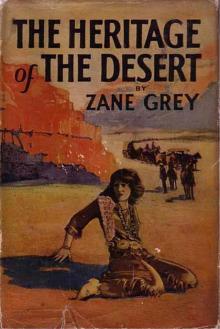 The Heritage of the Desert: A Novel
The Heritage of the Desert: A Novel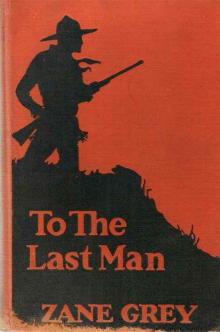 To the Last Man
To the Last Man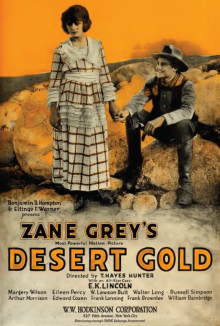 Desert Gold
Desert Gold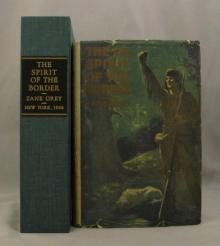 The Spirit of the Border: A Romance of the Early Settlers in the Ohio Valley
The Spirit of the Border: A Romance of the Early Settlers in the Ohio Valley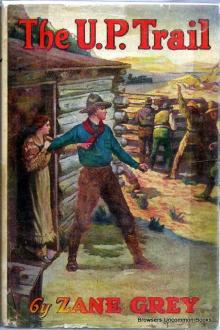 The U. P. Trail
The U. P. Trail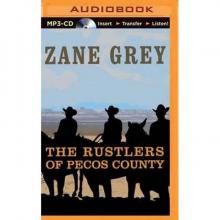 The Rustlers of Pecos County
The Rustlers of Pecos County The Border Legion
The Border Legion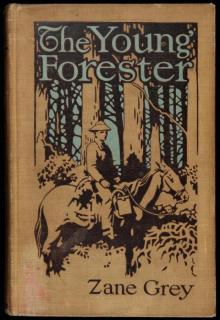 The Young Forester
The Young Forester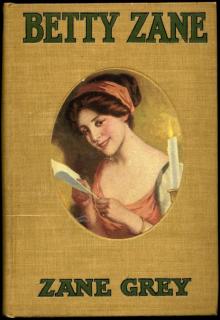 Betty Zane
Betty Zane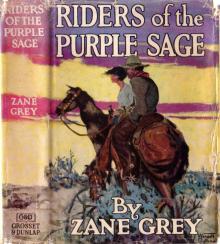 Riders of the Purple Sage
Riders of the Purple Sage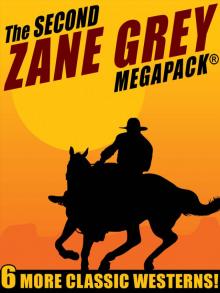 The Second Zane Grey MEGAPACK®
The Second Zane Grey MEGAPACK® The Rainbow Trail
The Rainbow Trail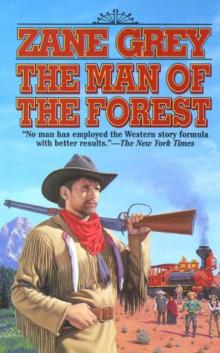 The Man of the Forest
The Man of the Forest The Mysterious Rider
The Mysterious Rider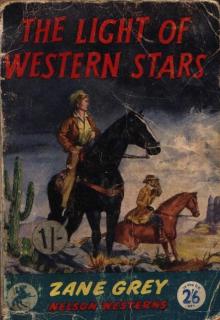 The Light of the Western Stars
The Light of the Western Stars The Last of the Plainsmen
The Last of the Plainsmen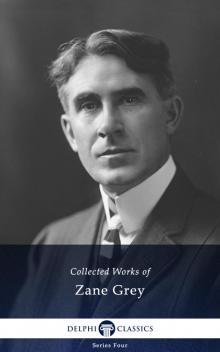 Collected Works of Zane Grey
Collected Works of Zane Grey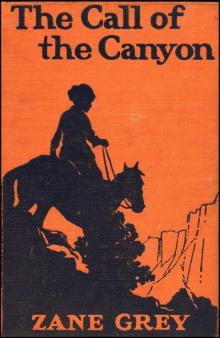 The Call of the Canyon
The Call of the Canyon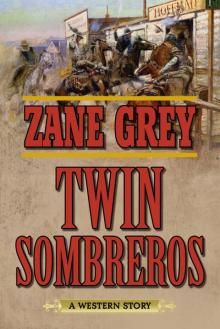 Twin Sombreros
Twin Sombreros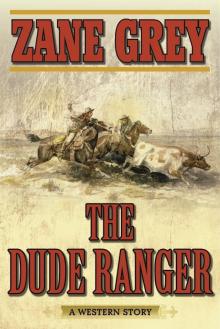 The Dude Ranger
The Dude Ranger The Water Hole
The Water Hole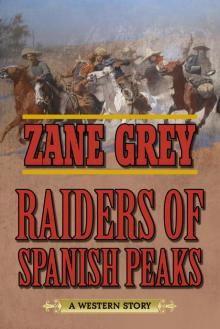 Raiders of Spanish Peaks
Raiders of Spanish Peaks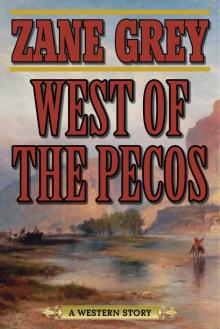 West of the Pecos
West of the Pecos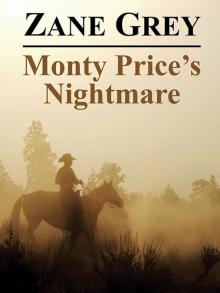 Monty Price's Nightmare
Monty Price's Nightmare Stairs of Sand
Stairs of Sand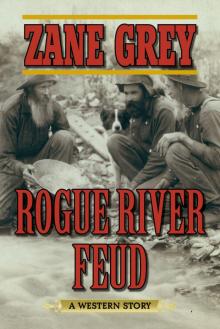 Rogue River Feud
Rogue River Feud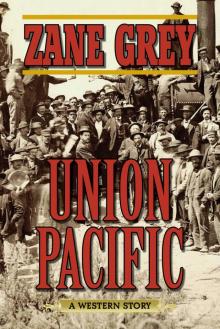 Union Pacific
Union Pacific The Western Romance MEGAPACK ®: 20 Classic Tales
The Western Romance MEGAPACK ®: 20 Classic Tales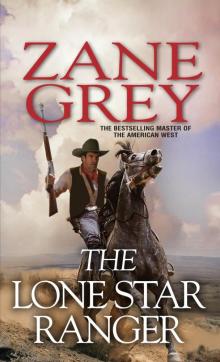 The Lone Star Ranger
The Lone Star Ranger The Zane Grey Megapack
The Zane Grey Megapack Shadow on the Trail
Shadow on the Trail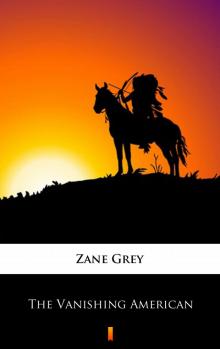 The Vanishing American
The Vanishing American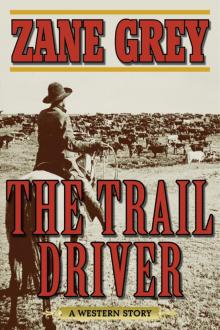 The Trail Driver
The Trail Driver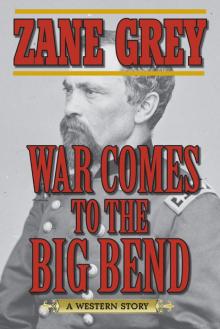 War Comes to the Big Bend
War Comes to the Big Bend The Westerners
The Westerners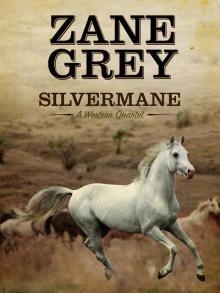 Silvermane
Silvermane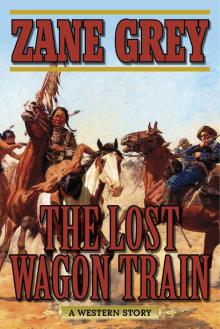 The Lost Wagon Train
The Lost Wagon Train Desert Gold and the Light of Western Stars
Desert Gold and the Light of Western Stars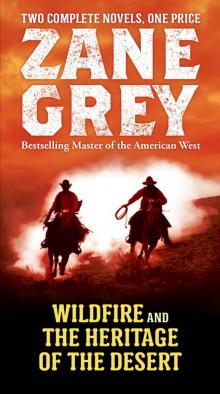 Wildfire and the Heritage of the Desert
Wildfire and the Heritage of the Desert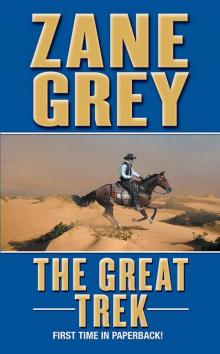 The Great Trek
The Great Trek Cabin Gulch
Cabin Gulch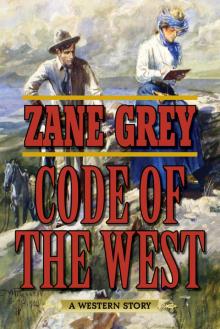 Code of the West
Code of the West Sunset Pass
Sunset Pass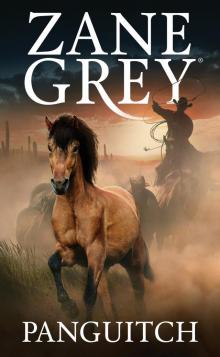 Panguitch
Panguitch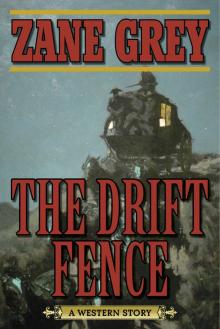 The Drift Fence
The Drift Fence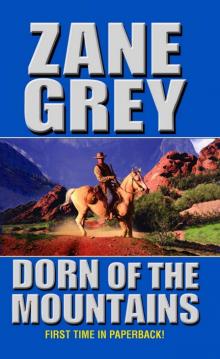 Dorn Of The Mountains
Dorn Of The Mountains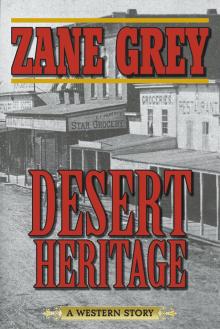 Desert Heritage
Desert Heritage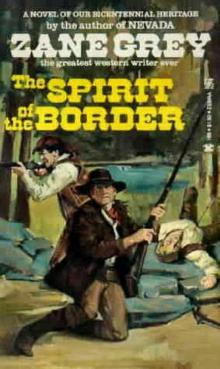 The Spirit Of The Border
The Spirit Of The Border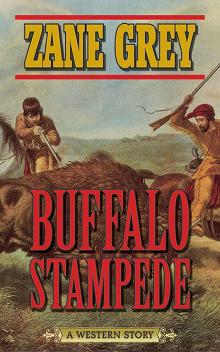 Buffalo Stampede
Buffalo Stampede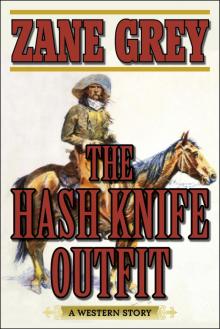 The Hash Knife Outfit
The Hash Knife Outfit The Lone Star Ranger and the Mysterious Rider
The Lone Star Ranger and the Mysterious Rider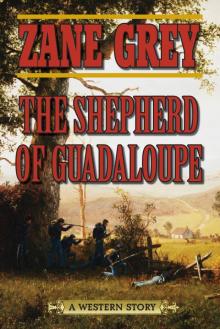 The Shepherd of Guadaloupe
The Shepherd of Guadaloupe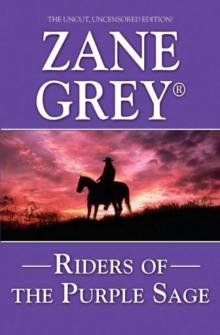 Riders of the Purple Sage (Leisure Historical Fiction)
Riders of the Purple Sage (Leisure Historical Fiction)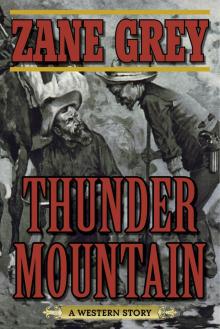 Thunder Mountain
Thunder Mountain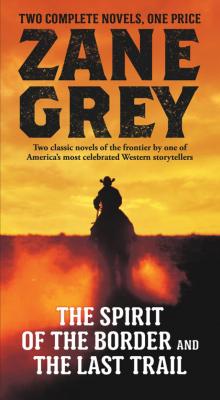 The Spirit of the Border and the Last Trail
The Spirit of the Border and the Last Trail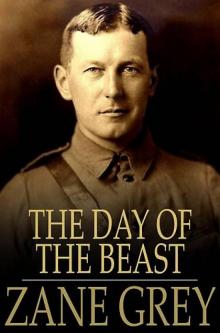 The Day of the Beast
The Day of the Beast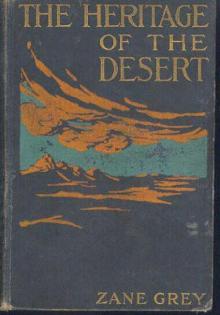 The Heritage of the Desert
The Heritage of the Desert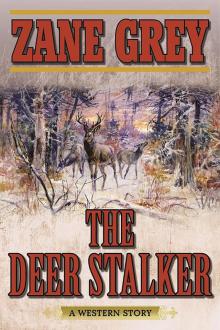 The Deer Stalker
The Deer Stalker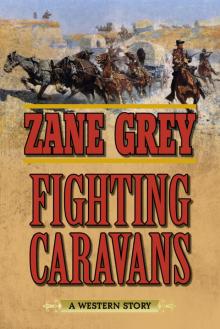 Fighting Caravans
Fighting Caravans